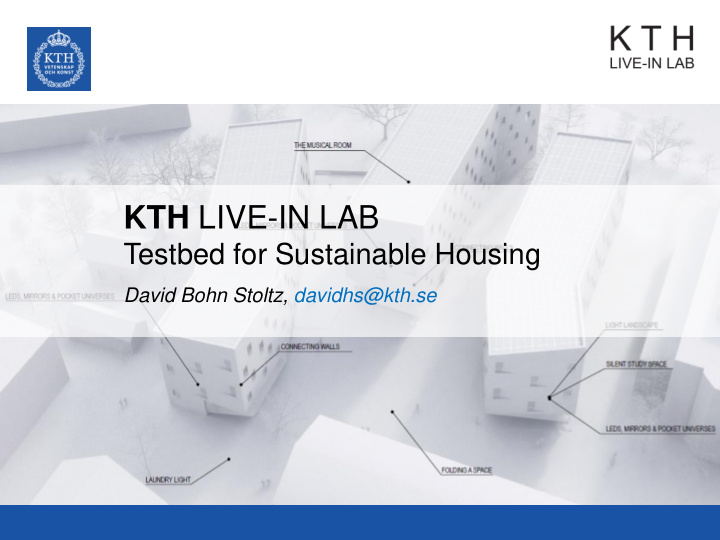



KTH LIVE-IN LAB Testbed for Sustainable Housing David Bohn Stoltz, davidhs@kth.se
A Testbed for Sustainable Housing “A testbed (also "test bed") is a platform for conducting rigorous, transparent, and replicable testing of scientific theories, computational tools, and new technologies .” (Wikipedia 20161107)
Need for 700 000 new (sustainable?) apartments in Sweden by 2025 https://static.dezeen.com/uploads/2015/05/Kolkajen-Ropsten-by-Adept_dezeen_ban.jpg https://corporate.vattenfall.se/globalassets/sverige/verksamhet/c3_forsmark_skog.jpg http://kraftverk.vattenfall.se/sites/default/files/lillgrund_01.jpg
Challenges to build sustainably Why build something else than what’s ordered? Why build better than what’s required? Not very logical when pretty much everything is sold on an overheated market anyway... Ref: www.green-panel.eu
Challenges are met in different ways • Technological development and innovation (New possibilities, better efficiency, lower cost) • Policy and Regulation (Legislation and incentives, taxes etc.) • Shifting consumer attitudes (awareness, motivation, lifestyles, new products with IoT, smart phones) • New Business Models (new entrants, values of flexibility and demand response etc.)
Innovation in the housing sector Berkers, E. & Geels, F.W., 2011. System innovation through stepwise reconfiguration: the case of technological transitions in Dutch greenhouse horticulture (1930 – 1980)
Innovation leading to new design http://www.bjornsbytare.se/pics/468217/1.jpg?1405159515
KTH Live-in Lab Purpose: to speed up the pace of innovation for “ green ”/” clean ” technologies in housing and construction sector • 305 student apartments • One passive lab • One active lab • Researchers from different fields as well as small and medium-sized enterprises
The lab is a unique collaboration that enables new opportunities • Gives new opportunities for collaboration between academia, students and enterprises • Gives SME’s an opportunity to test new technologies in a “real” environment, but in controlled forms with low risk • Aim to unlock and facilitate entrepreneurial spirit and creativity
KTH Live-in Lab Some short facts: Energy use around 230 000 kWh ~1150 sqm PV ~50 waste water heat exchangers Ground source heat pumps with novel heat collectors Long and short term heat storage (Hot water and PCM) Result: Plus energy building
KTH Live-in Lab – Examples of tech solutions Solar cells on the roof 5G compatibility Hållbarhet Ventilation with heat recovery Innovation Sensors Entreprenörskap Smart white goods Building permit free Waste water 13 boreholes Retention basin heat exchangers for stormwater Hot water storage Active Lab
KTH Live-in Lab
KTH Live-in Lab seen from the NE
The Student Apartments (Passive Lab)
Building permit free innovation area
Flexible innovation area The design is depending on the research projects
Education – Proposals from students
KTH LIVE-IN LAB is Live!
Ongoing research
Right now …
Yearly Activityplan
Testsite Campus KTH Live-In Lab Education Building ”Old” Campus
Will KTH Live- in Lab “spread” out from the KTH campus? Stockholm Royal Seaport
Stockholm Royal Seaport is being built incrementally – Suitable for a Living Lab? This is just an idea! …or perhaps a vision? 1. 2012-2014 (start 2011) Student apartments 2. 2014-2017 (start 2012) built in an early stage 3. 2017-2021 (start 2015) (Stage 2) 4. 2016-2017 (start 2014) 5. 2018 (start 2016) 6. 2018-2019 (start 2015) 7. 2018-2019 (start 2016) 8. 2020-2023 (start 2017) 9. 2019 (start 2017)
KTH LIVE-IN LAB has been made possible thanks to a donation from Einar Mattsson Tackar! David Bohn Stoltz davidhs@kth.se www.liveinlab.kth.se
Recommend
More recommend